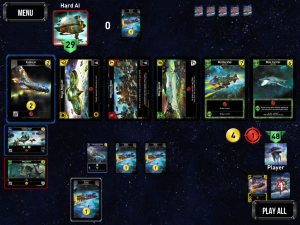My Insider pieces on the Andrew Miller signing by the Yanks and the three-team Yanks/Tigers/Dbacks trade are up for Insiders.
The runaway success of Dominion, which appears twice in the top ten of my boardgame rankings (once for the original game, another for the standalone Intrigue expansion), has spurred a huge boom in deckbuilding games of all stripes, many hybrids that incorporate other game types, but some that just take the basic Dominion formula and tweak it with new themes and slight changes to mechanics. I haven’t seen any takeoffs quite as faithful to Donald Vaccarino’s original game as Star Realms, a Kickstartered two-player deckbuilder that borrows liberally from Dominion, with the primary difference the change in goal from victory points to direct combat.

Each action card has one or more features that can be used any time it’s played, including monetary value, attack points, authority points (like a healing spell), or the ability to scrap (trash) a card from your hand or discard pile (think Chapel strategy if you’re a Dominion fan). Cards may also have a one-time ability that comes from trashing the card, again things like damage or added purchasing power. The interactions between cards allow for rapid gains in powers as the game progresses, and produces a slight benefit to focusing your card purchases in, say, two of the four categories/colors, although in my experience playing dozens of games in the app, you’re better off purchasing the best card available than taking a weaker card just to stay within a preferred color.
Those interactions are particularly useful when you play one or more bases, cards that remain on the table for future turns. Such a move gives you a better chance of one of those interactions the next time around, which can mean doubling your attack points or your cash, or getting the ability to draw another card or trash one. These bases also have their own point values for defense if your opponent chooses to attack one of them and remove the special ability it grants you. Some bases are Outposts, which also prevent your opponent from hitting your main base of authority points until s/he destroys the Outpost too. Unfortunately, once the attack points values start reaching 8-10 regularly by any game’s midpoint, no Outpost is going to survive another turn, which I find one of the game’s biggest flaws – if I play a card to the table intending to use it next turn, but there’s basically no chance it survives that long, then it hasn’t done me much more good than a typical card I’d play and move to my discard pile.
The iPhone/iPad itself is free, but better AIs are in-app purchases and well worth the cost – the free app is just a tutorial, in essence, but the hard AI was good for forcing me to learn some strategy. The campaign in the app is very entertaining because it changes the ground rules and/or starts your opponent with different configurations of cards and points, so the game itself gets a lot of variation. Without that, however, the game would have become stale for me; it’s too much like Dominion, and while the combat angle provides an element of direct competition that the base Dominion game lacks, it’s not like there’s a whole lot you can do to stop your opponent, either, so it’s more a matter of hoping the lumps you take are less than the ones you dish out.
By far the best thing about the physical game is its price: For $12, you get a real game with plenty of replay value that would fit in someone’s stocking. Try putting Power Grid or Agricola in an oversized sock hanging by the chimney and see if you don’t pull the whole mantle down in the process. There are also some expansions (called Crisis, coming in little packets like old-school baseball card packs) coming soon that I expect will address some of the weaknesses in the main game – the minimal utility of bases and the too-strong resemblance to Dominion. Until then, it’s a good game for the price, but more of a trifle than a staple like its ancestor.

IMO, the comp you’re looking for is Ascension. I don’t think it’s anything like Domininon, really.
@BIP: Really? The core mechanic is lifted straight from Dominion. Ascension itself has some similarities to Dominion too.
It’s like Dominion in that they are both deckbuilding games, sure, but the partculars of gameplay are much more comparable to Ascension (refreshing card row, infinite buys/actions, cards you can put into play on a [theoretically] permanent basis).
I get that Dominion is the most well-known and accessible deckbuilding game, so it’s reasonable to mention it as similar for people who aren’t familiar with the genre, but for people who regularly play deckbuilding games, a more precise comp better conveys the mechanics and style of Star Realms.
Ascension is itself a direct descendant of Dominion, so this is a specious criticism. Star Realms borrows the 7/3 setup, the five-card hand, and many card names from Dominion – a format that far more readers will recognize than if I claimed Star Realms was like the more obscure Ascension.
Thanks for reviewing ! I’ve been one of your readers pushing this game, so I’m glad you at least somewhat enjoyed it, or at the least did not regret purchasing it. It’s been pretty much my staple “board game” on my mobile devices since purchasing, though I largely agree with the weaknesses you point out in your review.